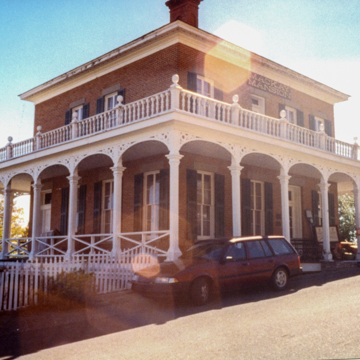Local tradition maintains that George Hearst built the Mackay Mansion, and it is possible that the future mining baron, who secured his start on the Comstock, was responsible for the construction of this three-story brick house. Built as the home and office of the superintendent of the famed Gould and Curry Mine, the building is one of the oldest substantial structures on the Comstock. Like the Chollar Mansion, this house has a hipped roof; a wraparound veranda with segmental arches, attenuated columns, and ornate jigsawn trim; and a cornice with dentils.
The structure became associated with bonanza king John Mackay after he won control of the Gould and Curry Mine. He probably lived in the house for a few months after the Great Fire destroyed his residence farther up the hill. After a visit to her husband's mine in 1874, Mary Louise Mackay supposedly came up with the idea of having a silver service made from some of the Comstock's silver. The Mackays commissioned Tiffany to design the service, which was made in 1877 and 1878. From one-half ton of silver sent directly from Virginia City to Tiffany in New York, a service of 1,250 pieces was produced. Although other affluent Americans, including the Vanderbilts, commissioned Tiffany to make silver services for them, the Mackay service received extensive publicity because of its size, opulence, and craftsmanship. It is now owned by the University of Nevada, Reno.

